Cuba’s Fascinating Babalú-Ayé Procession Honors African and Catholic Traditions
On December 17, Cubans perform a ritual pilgrimage for a powerful deity that can bring good health or can take it away
/https://tf-cmsv2-smithsonianmag-media.s3.amazonaws.com/filer/8a/55/8a551d45-96dc-4f3e-a23a-508bc5f61308/4231206357web.jpg)
After more than 50 years of economic embargo and political brinksmanship, the announcement one year ago of the renewal of diplomatic relations between Cuba and the United States came as a surprise. Washington, D.C., had been awash in rumors that a change was in the offing, but almost no one guessed at the magnitude of this remarkable development in global geopolitics. For many, particularly Cuban exiles around the world, it was one of those unforgettable historic moments, like the first man on the Moon or the fall of the Berlin Wall.
Some called it a miracle, as it occurred on an auspicious day for Cubans.
“Isn’t it amazing that this occurred on December 17,” exclaimed Cuban-American anthropologist Ruth Behar in a piece she wrote for the Washington Post. “It’s a day of great significance to Cubans, when thousands of them make an annual pilgrimage to the shrine of Rincón to mark the feast day of San Lázaro.”
Many of my Cuban friends and colleagues told me that this momentous event “had” to take place on this day. Since 1992, I have been visiting Cuba as an ethnographer and researcher of a unique Afro-Cuban tradition that honors both the Catholic St. Lazarus and the African-inspired Babalú-Ayé. (Yes, this is the same Babalú that performer Desi Arnaz sang to in “I Love Lucy.”)
In Cuban Catholicism, Lazarus, the patron saint of the poor and sick, is represented as a homeless beggar surrounded by dogs. Some say he was a fourth-century bishop, but most Cubans imagine him as the Biblical Lazarus—the poor man who cannot enter the kingdom of heaven, who Jesus raises from the dead. Cuba’s Lazarus works miracles for the destitute and the infirm, making him one of the country’s most popular saints.
In the African-inspired religious tradition known as Santería or Oricha, Babalú-Ayé is both feared and beloved. Thought to be responsible for bringing epidemics like smallpox, leprosy and AIDS, Babalú-Ayé also cures these diseases. Oricha elders tell of his exile from his homeland with the Lucumí because he spread smallpox among them, and they tell of his journey to the Arará, who were healed by him and ultimately made him their king.
The elders teach that he is an irascible old man and so mysterious that his omnipotence is nearly impossible to comprehend. They also teach that everyone should always pray for health, and Babalú is one of the guarantors of this most important blessing.
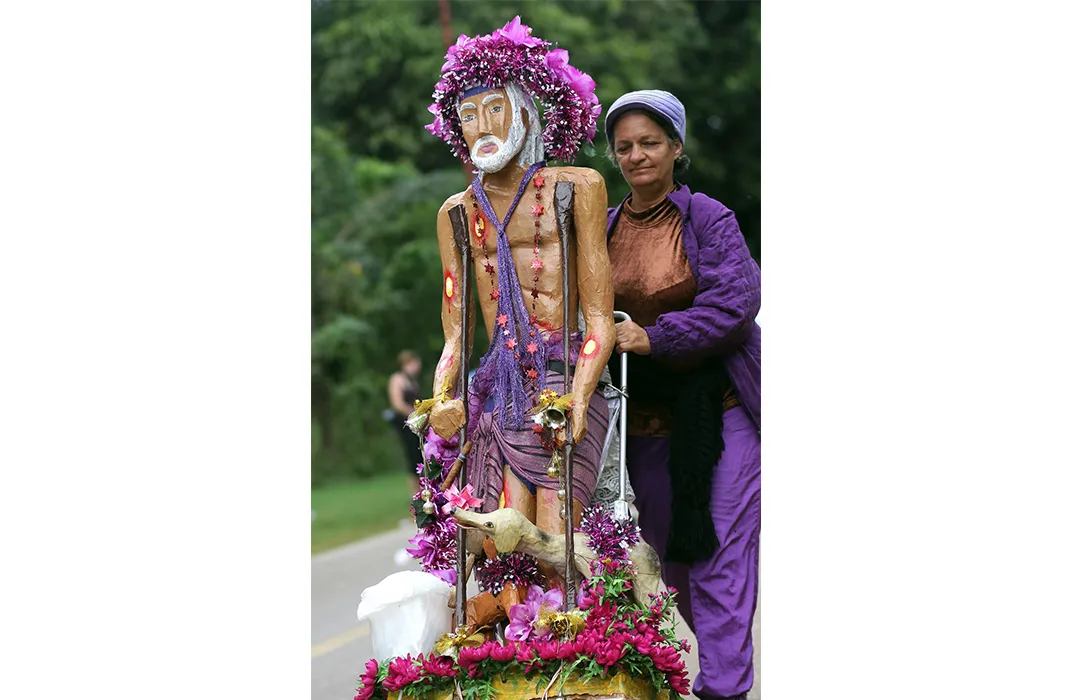
Cubans know poverty and illness. Before the American occupation of Cuba in 1902, scarlet fever epidemics erupted almost every year, and thousands died. Before the Cuban Revolution, many agricultural workers lived through annual cycles of poverty and hunger as they waited for the sugar harvest to provide work. More recently, the collapse of the Soviet Union in 1989 resulted in an economic contraction of some 50 percent, and again many Cubans went hungry.
On my first research trip in 1992, as a guest of the Academy of Sciences, my single daily meal consisted of one cup of rice and one fried egg each day, along with mangos and coffee.
On December 17, pilgrims flood the streets of Rincón, home to a leprosarium and a church dedicated to Saint Lazarus. Some have flown into Havana from overseas and traveled the 25 miles to the little town. Some have walked from their homes in Santiago, and others from Bejucal, the next town over.
Around dusk, the police shut down the main road to cars in order to accommodate the crowds. So central is walking to this enterprise that people call it the caminata—the special walk, instead of a pilgrimage.
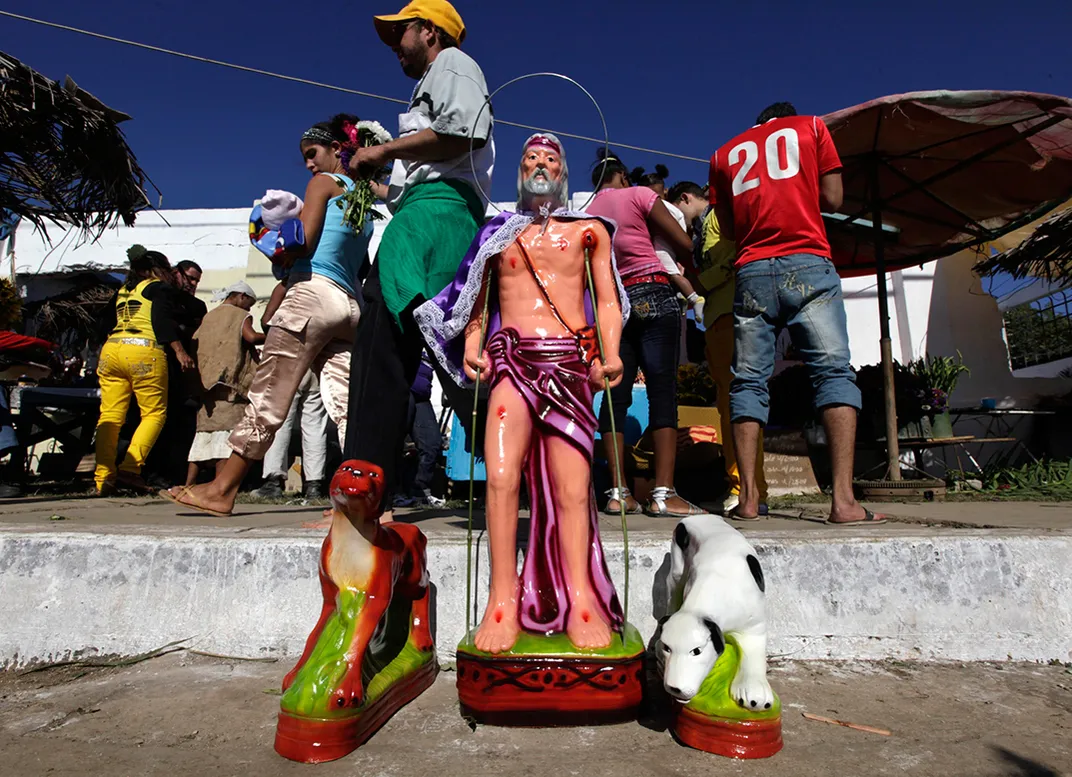
Popular images of Saint Lazarus show him dressed in sackcloth and walking on crutches along a road that leads toward a distant tower. (Stories about Babalú-Ayé also include his walking long distances.) By the end of the day, most everyone in Rincón will make their way to the church.
Some people push a carretilla, a little cart. Like the modest altar for alms, these improvised carts usually include a statue of St. Lazarus. Often the statue is cloaked in burlap and wearing a red cloth—just like the famous "miraculous image" of St. Lazarus found within the sanctuary of the church in Rincón.
Pilgrims often fill their carretillas with the offerings of flowers, candles and coins for alms. Sometimes they blow cigar smoke at the images of the saint—similar to an African-inspired tradition of blowing smoke onto an altar.
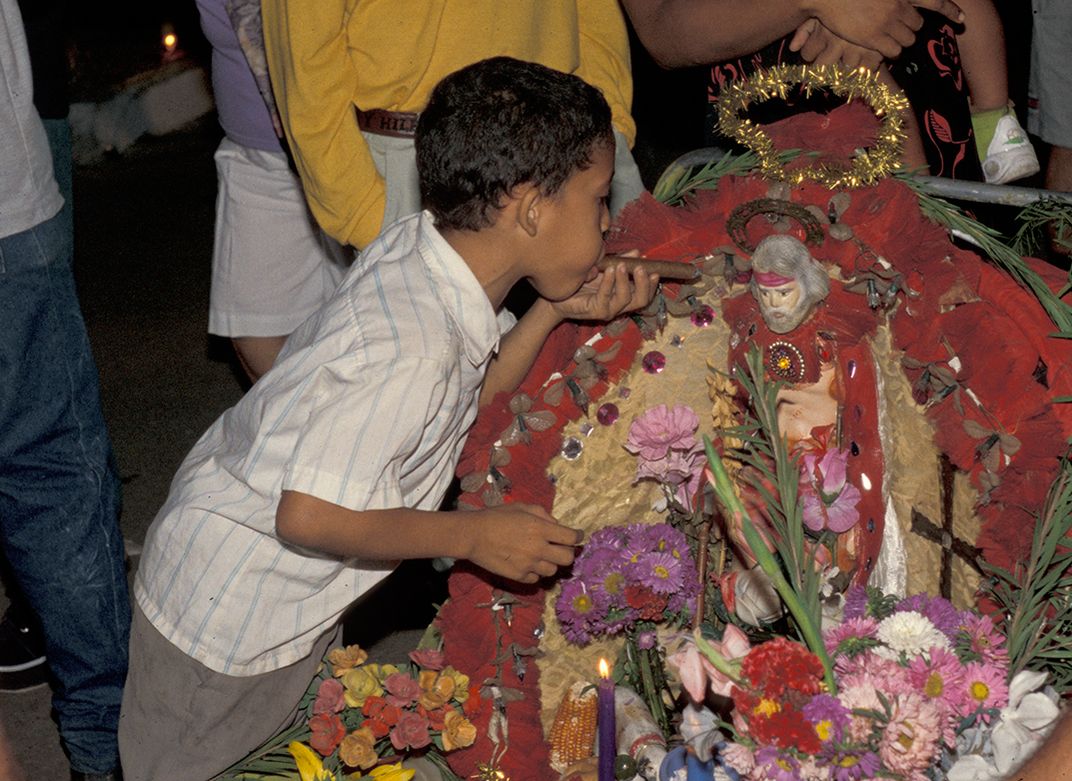
Many people perform these acts of devotion because of a promise—they are keeping their word to the spirit after he granted their petitions. Still others do these things as solemn acts of prayer—gestures designed to solicit the saint’s attention.
Some people dress in sackcloth and carry crutches. They walk jorobado—hunchbacked—just like Babalú-Ayé did when he was wandering the desolate places of the Earth. At his darkest moment, Babalú-Ayé was completely crippled and could not even walk. So urgent was his journey that he kept moving forward, dragging himself along the road toward his destination, or as the religious elders would say, his destiny.
And so the devoted grimly lie down on the ground and drag themselves forward. Others turn on their backs and use their legs to propel themselves, scraping their clothes and their flesh on the hard pavement. Often you cannot see them on the dark road, but the experience of hearing the moans of their suffering rising into the night is as eerie and discomfiting as it is difficult to describe.
Whether their journey began in Havana, or in the nearby towns, or at the police barricade at the edge of Rincón: All of them pay homage to the deity by becoming dusty and bloody—reminding us of the precarious and raw quality of human life.
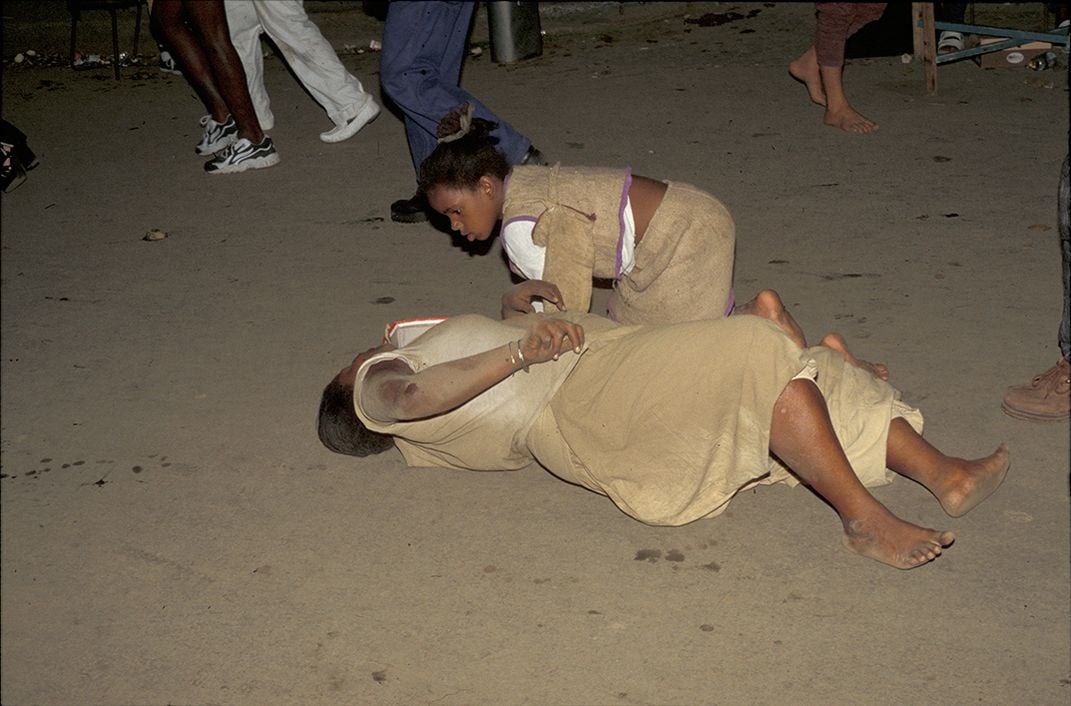
All are headed to the church. And all of them seek to heal their wounds. Once they arrive, they await the arrival of his feast day, December 17.
At the same time that the streets of Rincón overflow with pilgrims, those not making the journey perform a complex ceremony in their homes.
The African-inspired world of Santería is complex, and different communities who practice the ritual in ways that maintain historical and geographical distinctions from those traditions practiced in Africa. All across the island, Cubans practice their own versions of the awán, a ceremony dedicated to Babalú-Ayé, where a basket is lined with sackcloth and encircled with plates of food. Some religious elders say 13 plates, some say 17 and some even say 77 plates must be present.
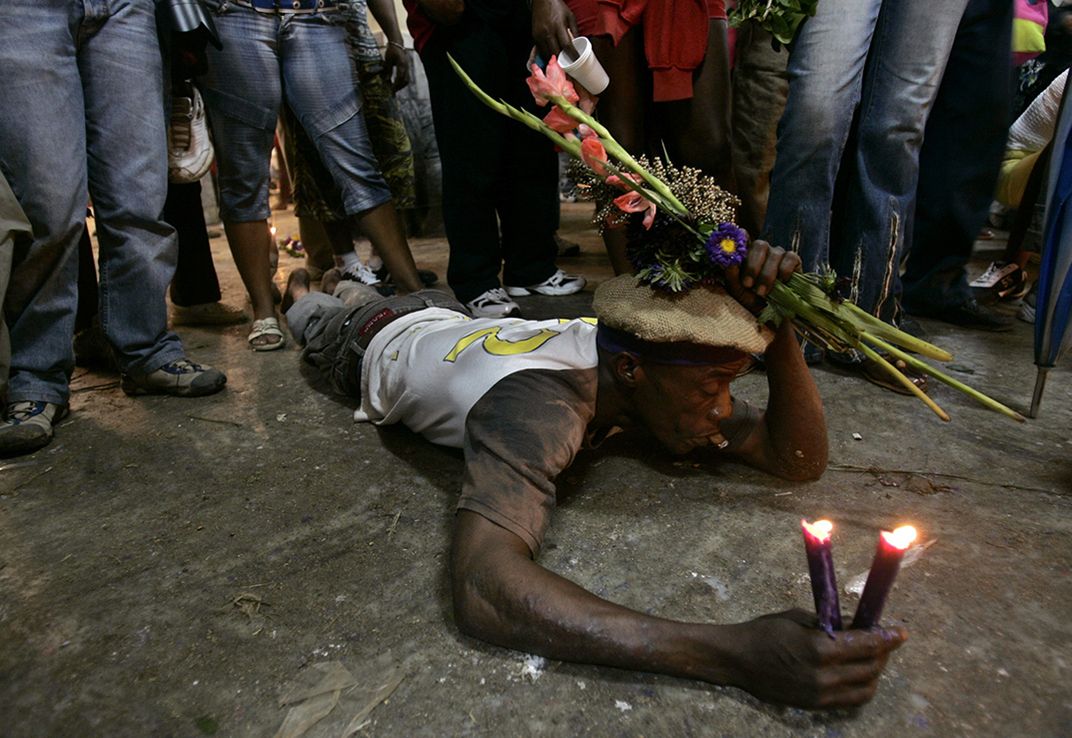
After sunset, participants gather round the basket, taking handfuls of food from each plate and rubbing it over their bodies to remove negativity or osobo. Each handful of food is then cast back into the basket, until everyone is cleansed. A speckled rooster, a guinea hen, two eggs and the já, the ritual broom of Babalú are used as part of the cleansing ritual. At the end people walk around the basket and sing praises for the deity.
Each religious lineage completed the awán ritual in different ways, but the essential elements remain across the island.
One awán follows the strictures of the Lucumí tradition, the Arará-Dajomé lineage popularized by the Armando Zulueta, who hailed from the small Cuban town of Perico in Matanzas Province. At the bottom of the basket, they layer crumbled charcoal, followed by a piece of bread smeared with palm oil and topped with seven guinea peppers. Each of these objects brings a material presence to some aspect of the Babalú-Ayé’s story.
In contrast, Pedro Abreu, a leading priest of the Arará-Sabalú lineage, begins another awán tradition by tracing a circle of chalk on the ground. Inside the circle a series of complex markings is made to invoke the key moments in the life history of Babalú-Ayé. Called atenas, these signs come from the divination system; each brings the specific aché—spiritual power—of the sign to bear on the awán and the lives of those who participate.
In the face of unprecedented political change on December 17, this day also remains one of ceremony and tradition in Cuba.
The Cuban people continue to honor St. Lazarus in Rincón and to perform the awán in their homes. They commemorate their history as a people, they acknowledge their human vulnerability, and they call out to be made whole.
/https://tf-cmsv2-smithsonianmag-media.s3.amazonaws.com/accounts/headshot/Mason_Michael-12012.jpg)



/https://tf-cmsv2-smithsonianmag-media.s3.amazonaws.com/accounts/headshot/Mason_Michael-12012.jpg)